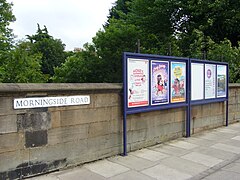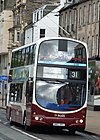
The West Coast Main Line (WCML) is one of the most important railway corridors in the United Kingdom, connecting the major cities of London and Glasgow with branches to Birmingham, Manchester, Liverpool and Edinburgh. It is one of the busiest mixed-traffic railway routes in Europe, carrying a mixture of intercity rail, regional rail, commuter rail and rail freight traffic. The core route of the WCML runs from London to Glasgow for 400 miles (644 km) and was opened from 1837 to 1881. With additional lines deviating to Northampton, Birmingham, Manchester, Liverpool and Edinburgh, this totals a route mileage of 700 miles (1,127 km). The Glasgow–Edinburgh via Carstairs line connects the WCML to Edinburgh. However, the main London–Edinburgh route is the East Coast Main Line. Several sections of the WCML form part of the suburban railway systems in London, Coventry, Birmingham, Manchester, Liverpool and Glasgow, with many more smaller commuter stations, as well as providing links to more rural towns.

The North Clyde Line is a suburban railway in West Central Scotland. The route is operated by ScotRail. As a result of the incorporation of the Airdrie–Bathgate rail link and the Edinburgh–Bathgate line, this route has become the fourth rail link between Glasgow and Edinburgh.
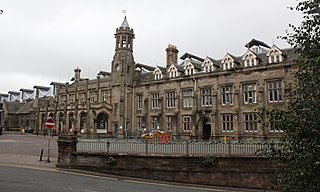
Carlisle railway station, or Carlisle Citadel, is a Grade II* listed railway station serving the cathedral city of Carlisle, Cumbria, England. It is on the West Coast Main Line, 102 miles (164 km) south-east of Glasgow Central and 299 miles (481 km) north north-west of London Euston. It is the northern terminus of the Settle and Carlisle Line, a continuation of the Midland Main Line from Leeds, Sheffield and London St Pancras. It was formerly the southern terminus of the partially-closed Waverley Route from Edinburgh. It is so named because it is adjacent to Carlisle Citadel, a former medieval fortress. The station is owned by Network Rail.

Gorgie is a densely populated area of Edinburgh, Scotland. It is located to the west of the city centre, and borders Murrayfield, Ardmillan and Dalry.

Slateford railway station is a railway station serving Slateford in the city of Edinburgh, Scotland. It is located on the Shotts Line from Glasgow Central to Edinburgh Waverley via Shotts. The station has two platforms, connected by a stairway footbridge, and CCTV. It is managed by ScotRail.

Stirling railway station is a railway station located in Stirling, Scotland. It is located on the former Caledonian Railway main line between Glasgow and Perth. It is the junction for the branch line to Alloa and is also served by trains on the Edinburgh to Dunblane Line and long-distance services to Dundee and Aberdeen and to Inverness via the Highland Main Line.

Dunblane railway station serves the town of Dunblane in central Scotland. It is located on the former Scottish Central Railway, between Stirling and Perth and opened with the line in 1848. It is the northernmost station on the National Rail network to be electrified.

Shettleston railway station serves the Shettleston area of Glasgow, Scotland and is 3½ miles (5 km) east of Glasgow Queen Street railway station on the North Clyde Line. The station is managed by ScotRail.
The City of Glasgow Union Railway – City Union Line, also known as the Tron Line, was a railway company founded in Glasgow, Scotland, in 1864 to build a line connecting the railway systems north and south of the River Clyde, and to build a central passenger terminus and a general goods depot for the city. The through line, running from south-west to north-east across the city, opened in 1870–71, and the passenger terminal was St Enoch railway station, opened in 1876. The railway bridge across the Clyde was the first in the city.
The Edinburgh Suburban and Southside Junction Railway was a railway company that built an east-west railway on the southern margin of Edinburgh, Scotland, primarily to facilitate the operation of heavy goods and mineral traffic across the city. The line opened in 1884. Although its route was rural at the time, suburban development quickly caught up and passenger carryings on the line were buoyant; the passenger service operated on a circular basis through Edinburgh Waverley railway station.

Strathbungo railway station was a railway station serving the village of Strathbungo, Glasgow, Scotland. The station was originally part of the Glasgow, Barrhead and Kilmarnock Joint Railway.
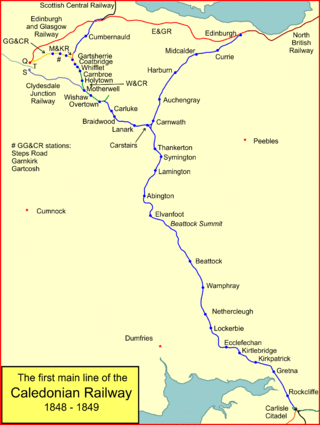
The Caledonian Railway main line in Scotland connected Glasgow and Edinburgh with Carlisle, via Carstairs and Beattock.

The Edinburgh, Leith and Newhaven Railway was a railway company formed in 1836 to connect the city of Edinburgh with the harbours on the Firth of Forth. When the line connected to Granton, the company name was changed to the Edinburgh, Leith and Granton Railway. It opened part of its route in 1846, but reaching the centre of Edinburgh involved the difficult construction of a long tunnel; this was opened in 1847. It was on a steep incline and was worked by rope haulage.

Gorgie East Railway Station was a railway station on the Edinburgh Suburban and Southside Junction Railway in Edinburgh, Scotland. It was opened on 1 December 1884 and served the Gorgie area of Edinburgh.
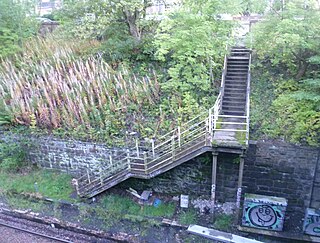
Craiglockhart Railway Station was a railway station in Scotland on the Edinburgh Suburban and Southside Junction Railway (SSJR). It was opened on 1 June 1887. Located on Colinton Road next to the Myreside Aqueduct of the Union Canal, it served the Craiglockhart area of Edinburgh, in the south-west of the city.
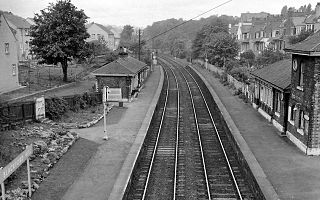
Blackford Hill railway station was a railway station in the Blackford area of Edinburgh, Scotland. It was located at the foot of Blackford Hill on the Edinburgh Suburban and Southside Junction Railway (ESSJR). It was opened on 1 December 1884.
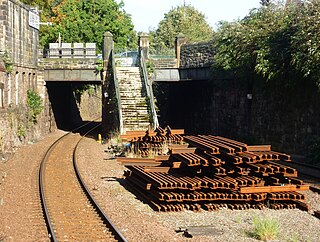
Newington Railway Station was a railway station in Edinburgh, Scotland, on the Edinburgh Suburban and Southside Junction Railway. It served the southern Edinburgh suburb of Newington and the station site is still visible from Craigmillar Park.
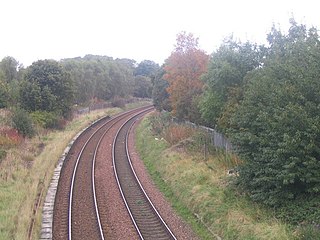
Duddingston & Craigmillar Railway Station was a railway station in Scotland on the Edinburgh Suburban and Southside Junction Railway. It served the Duddingston and Craigmillar areas of Edinburgh's south side. It was opened on 1 December 1884.

The Shotts Line is a suburban railway line in Scotland linking Glasgow Central and Edinburgh Waverley via Shotts. It is one of the four rail links between the two cities.
The Wilsontown, Morningside and Coltness Railway was a railway opened in 1845, primarily for mineral traffic, although a passenger service was run sporadically. The line ran from a junction with the Wishaw and Coltness Railway at Chapel, to Longridge, in South Central Scotland, and it was extended to Bathgate in 1850 after takeover by the Edinburgh and Glasgow Railway. It was built to open up further coal deposits and to connect the Wilsontown Ironworks, although it did not actually reach Wilsontown. In common with the other "coal railways" with which it connected, it adopted the track gauge of 4 ft 6 in, often referred to as Scotch gauge.



